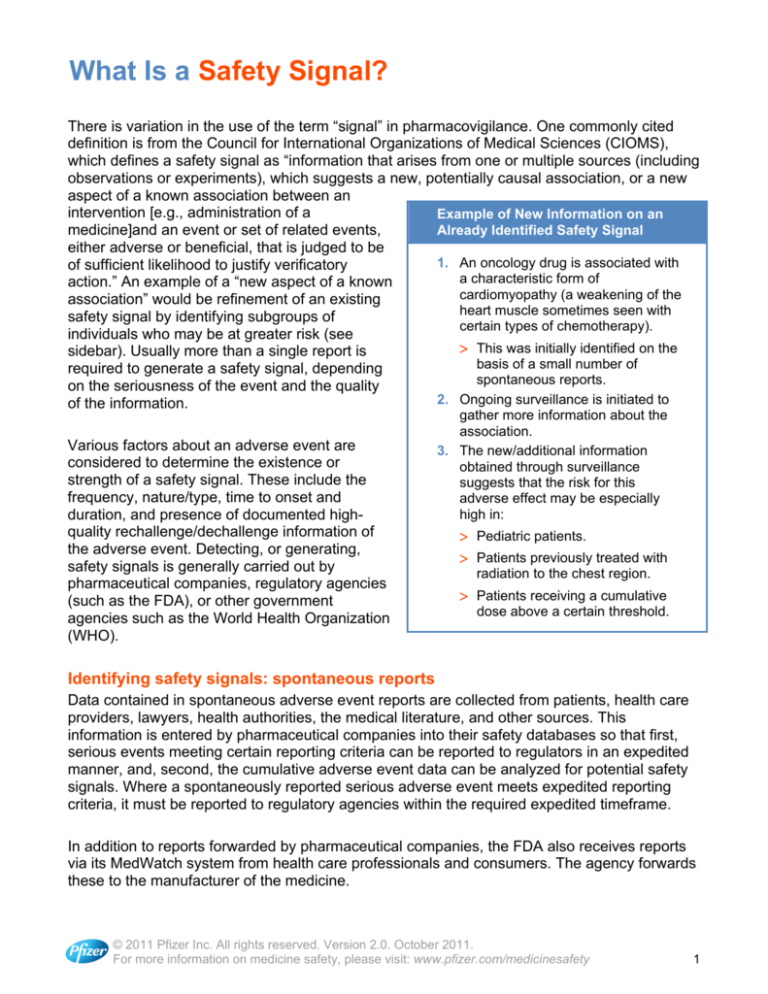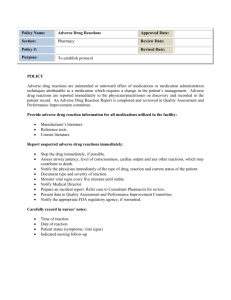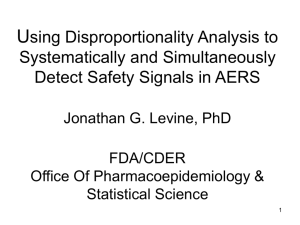
What Is a Safety Signal?
There is variation in the use of the term “signal” in pharmacovigilance. One commonly cited
definition is from the Council for International Organizations of Medical Sciences (CIOMS),
which defines a safety signal as “information that arises from one or multiple sources (including
observations or experiments), which suggests a new, potentially causal association, or a new
aspect of a known association between an
intervention [e.g., administration of a
Example of New Information on an
Already Identified Safety Signal
medicine]and an event or set of related events,
either adverse or beneficial, that is judged to be
1. An oncology drug is associated with
of sufficient likelihood to justify verificatory
a characteristic form of
action.” An example of a “new aspect of a known
cardiomyopathy (a weakening of the
association” would be refinement of an existing
heart muscle sometimes seen with
safety signal by identifying subgroups of
certain types of chemotherapy).
individuals who may be at greater risk (see
> This was initially identified on the
sidebar). Usually more than a single report is
basis of a small number of
required to generate a safety signal, depending
spontaneous reports.
on the seriousness of the event and the quality
2. Ongoing surveillance is initiated to
of the information.
Various factors about an adverse event are
considered to determine the existence or
strength of a safety signal. These include the
frequency, nature/type, time to onset and
duration, and presence of documented highquality rechallenge/dechallenge information of
the adverse event. Detecting, or generating,
safety signals is generally carried out by
pharmaceutical companies, regulatory agencies
(such as the FDA), or other government
agencies such as the World Health Organization
(WHO).
gather more information about the
association.
3. The new/additional information
obtained through surveillance
suggests that the risk for this
adverse effect may be especially
high in:
> Pediatric patients.
> Patients previously treated with
radiation to the chest region.
> Patients receiving a cumulative
dose above a certain threshold.
Identifying safety signals: spontaneous reports
Data contained in spontaneous adverse event reports are collected from patients, health care
providers, lawyers, health authorities, the medical literature, and other sources. This
information is entered by pharmaceutical companies into their safety databases so that first,
serious events meeting certain reporting criteria can be reported to regulators in an expedited
manner, and, second, the cumulative adverse event data can be analyzed for potential safety
signals. Where a spontaneously reported serious adverse event meets expedited reporting
criteria, it must be reported to regulatory agencies within the required expedited timeframe.
In addition to reports forwarded by pharmaceutical companies, the FDA also receives reports
via its MedWatch system from health care professionals and consumers. The agency forwards
these to the manufacturer of the medicine.
© 2011 Pfizer Inc. All rights reserved. Version 2.0. October 2011.
For more information on medicine safety, please visit: www.pfizer.com/medicinesafety
1
What Is a Safety Signal? (cont’d)
All spontaneous reports received by the FDA are entered into the Adverse Event Reporting
System (AERS), a database designed to support the FDA’s post-approval safety surveillance
program. AERS contains data for all approved medicines and therapeutic biologic products,*
with a goal of providing a vehicle for signal detection by the agency.
The post-approval spontaneous safety reporting systems maintained by pharmaceutical
companies and regulatory agencies contain substantially larger volumes of data than preapproval databases, which are mainly based on clinical study data. Although useful,
spontaneous reports have some limitations, which make interpretation of the data difficult.
One consideration is how to interpret the numbers when generating safety signals.
Spontaneous report system data do not inherently include true “denominators,” a word used to
describe the entire population of patients who have taken a drug. For example, if 20 individual
safety reports (ISRs) report a specific adverse event when taking drug A, does this represent
20 out of 250 comparable patients using the drug in the real world, or 20 out of 10,000? And if
80 ISRs of that same adverse event are reported for drug B (again, without knowing the
relevant denominator for both drugs), how does this compare to drug A?
Another factor is the phenomenon of “masking.” The ability to detect a statistically distinctive
reporting association depends on the number of ISRs specific to that association relative to the
overall reporting of the drug (across all events) and the event (across all drugs). Drug
interactions or rare patient characteristics, however, typically show up in relatively small
numbers of ISRs. In such instances, one bad medicine can make others look good (when this
may not be the case), and a signal’s disproportionate effect (even if it is true) will not show up
when the numbers are too small to demonstrate significant differences.
Identifying safety signals: other sources
In addition to spontaneous reports, clinical study data, both pre- and post-approval, play a key
role in understanding a medicine’s benefit-risk profile. Pharmaceutical companies also use this
information to detect signals of potential adverse medicine effects. These signals are then
evaluated through a careful review of the cases and a search for additional cases, as well as
through epidemiology studies, discussed in a separate briefing document in this series (“How
Is Epidemiology Used in Risk Management Planning and Safety Assessment?”), available in
the Medicine Safety Timeline section and Resource Library at www.pfizer.com/medicinesafety.
Regulatory agencies and academic researchers may also use databases of clinical study
results as a source for identifying safety signals—for example, ClinicalTrials.gov in the U.S.
Other useful sources of information include the many databases and registries that are
maintained by health agencies worldwide—for example, the WHO Collaborating Center for
International Drug Monitoring database in Uppsala, Sweden, the General Practice Research
Database in the United Kingdom and health insurance databases in the U.S.
*http://www.fda.gov/cder/aers/default.htm
© 2011 Pfizer Inc. All rights reserved. Version 2.0. October 2011.
For more information on medicine safety, please visit: www.pfizer.com/medicinesafety
2
What Is a Safety Signal? (cont’d)
Data mining
In addition to the traditional hands-on review of spontaneous cases and other safety
information by trained medical personnel, “data mining” may also be carried out. This is the
process of applying sophisticated statistical algorithms to large safety databases to determine
whether certain adverse events (AEs) are being reported for a medicine with a greater
frequency than expected (i.e., a signal of disproportionate reporting, or SDR), based on a
statistical model. For example, a score can be generated for a particular AE-medicine
combination (e.g., frequency of bleeding disorder with Drug X) and compared with the score
for all medicines in the database (i.e., frequency of bleeding disorder across all medicines).
When the AE-Drug X score is greater than the AE-all medicine score, a safety signal may have
been detected, depending on the clinical context, since such a number in a biological vacuum
does not necessarily constitute a signal of suspected causality. Other available tools (varying
in degrees of development) include regression analysis, clustering, link analysis, deviation
detection, disproportionality measures, and neural networks. These quantitative methodologies
go beyond basic signal detection to assess patterns, time trends, and events associated with
more complex phenomena such as drug-drug interactions, which may be more difficult to link
by manual review.
It is crucial to remember that the mathematical procedures underlying contemporary data
mining cannot fully correct or neutralize the limitations of spontaneous reporting system data.
An SDR provides a suggestion of increased spontaneous reporting based on a model.
Although such models may be useful, it is of course impossible to know with certainty how
many reports of a given drug-event combination are expected. While data mining of
spontaneous reporting system data can provide indicators of increased reporting, it cannot
provide information on the cause of increased reporting, which in addition to (or instead of)
causality, may reflect any one or more of numerous reporting artifacts, confounding factors,
and/or the play of chance.
Ultimately, no matter how sophisticated the statistical and quantitative tools that are available,
qualitative medical review and assessment are necessary to guide the quantitative analysis
and evaluation. In other words, clinical context and medical review are required to determine
whether a potential adverse event signal that has been identified merits focused analysis. For
example, data mining might correspond to:
• Reporting of the treatment indication as an adverse event, or
• A safety issue that is already known and has been fully investigated.
In these instances, further evaluation would not generally be needed.
© 2011 Pfizer Inc. All rights reserved. Version 2.0. October 2011.
For more information on medicine safety, please visit: www.pfizer.com/medicinesafety
3
What Is a Safety Signal? (cont’d)
Investigating safety signals
Potential signals identified through qualitative and/or quantitative methods can be evaluated
using more reliable data sources such as observational/pharmacoepidemiologic studies,
additional randomized clinical studies, or mechanistic studies.
Safety signals that warrant further investigation include, but are not limited to:
• New adverse events, not currently documented in the product label, especially if serious
and in rare untreated populations.
• An apparent increase in the severity of an adverse event that is already included in the
product label.
• Occurrence of serious adverse events known to be extremely rare in the general
population.
• Previously unrecognized interactions with other medicines, dietary supplements, foods,
or medical devices.
• Identification of a previously unrecognized at-risk population, such as populations with
specific genetic or racial predisposition or coexisting medical conditions.
• Confusion about a product’s name, labeling, packaging, or use.
• Concerns arising from the way a product is used (e.g., adverse events seen at doses
higher than normally prescribed, or in populations not recommended, in the label).
• Concerns arising from a failure to achieve a risk management goal.
© 2011 Pfizer Inc. All rights reserved. Version 2.0. October 2011.
For more information on medicine safety, please visit: www.pfizer.com/medicinesafety
4








